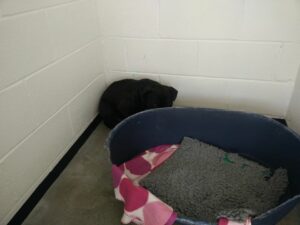Can dogs get Post Traumatic Stress Disorder (PTSD)?
In the event “Identifying Traumatised Dogs and How to Support Them” Debbie Busby presented on identifying PTSD in dogs and how it may differ from other anxiety disorders.
Post Traumatic Stress responses are a normal physical and emotional response to a traumatic event. PTSD occurs where the dog’s body does not return to baseline levels after around 4 weeks, and symptoms interfere frequently in their lives. With similar biology and presenting symptoms to humans we can absolutely say that dogs suffer from what we would recognise as PTSD.
Symptoms of PTSD in dogs
 Trauma survivors are likely to interpret even neutral stimuli in line with their traumatic memories. Think about the Rorschach inkblot test, someone without trauma may see a butterfly, whilst someone with trauma is more inclined to see something connected to their trauma. This also happens in real life where seemingly non-threatening events, objects, sounds or movements may suddenly trigger anxiety as the individual’s brain is wired to recognise and respond to anything it perceives as similar, as if it were dangerous. The brain has been reset to interpret the world as unsafe.
Trauma survivors are likely to interpret even neutral stimuli in line with their traumatic memories. Think about the Rorschach inkblot test, someone without trauma may see a butterfly, whilst someone with trauma is more inclined to see something connected to their trauma. This also happens in real life where seemingly non-threatening events, objects, sounds or movements may suddenly trigger anxiety as the individual’s brain is wired to recognise and respond to anything it perceives as similar, as if it were dangerous. The brain has been reset to interpret the world as unsafe.
The response is not conscious, it is not a choice. It happens in a deep area of the brain associated purely with keeping the individual safe.
Traumatised individuals may learn to be helpless and unable to problem solve. Studies show that traumatised dogs will not jump over even small barriers to escape electric shock. They anticipate that they have no control over negative events even if it may seem obvious to others that it could be avoided.
Symptoms of PTSD in dogs may include:
- Apparent personality/temperament change.
- New fears and phobias (not present before the traumatic event).
- Chronic chewing or paw licking.
- Depression.
- Trembling.
- Hypersalivation.
- Pacing.
- Aggressive behaviour.
- Loose stools/vomiting/lack of appetite/new toileting in the house.
- Avoidance of certain things/people etc.
- Fear of certain specific, related triggers or contexts.
How to help a dog with PTSD
The journey is a slow and gentle one. Start by prioritizing the basics. Avoid triggers and ensure a diverse and nutritious diet, along with creating safe and comfortable resting spaces. Make certain they get ample high-quality sleep daily and offer as many appropriate choices as they can handle, letting their preferences guide their social interactions.
Introduce manageable enrichment activities that encourage movement and decision-making. These activities stimulate the brain and body, promoting positive emotions and propelling progress. Tailor these activities to the individual, adding new ones as they advance.
Keep treats handy and reward positive choices promptly. Whether it’s finding a relaxing spot or any other favorable decision, acknowledge and reinforce these choices by placing a treat nearby whenever you witness them.
Professional help
Helping dogs with PTSD often requires the support of a team. Just like with humans with PTSD, there are different professionals who will bring a different piece of the puzzle. Although there is no quick fix, support and guidance will reassure you that you are doing all they can to help your dog to live the fullest possible life.
I am a Clinical Animal Behaviourist based in the Worcestershire area and working successfully using online training procedures anywhere in the world. All you need is your dog, and a device with an internet connection! I can help to make sure you and your dog are on the right path.


